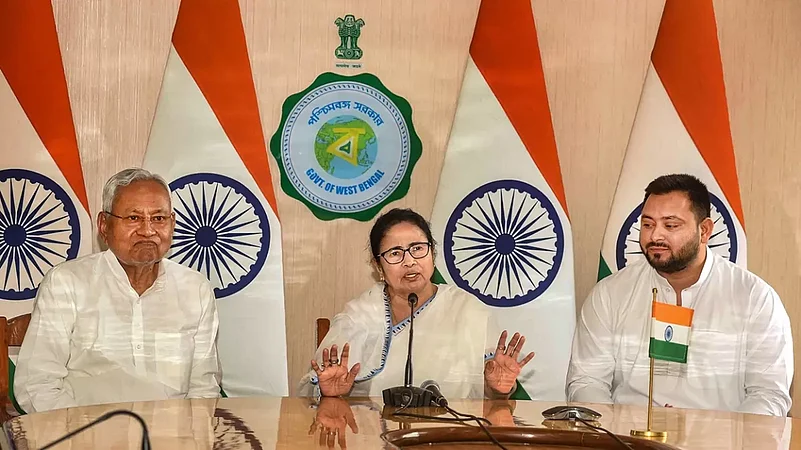The shaky start to the Opposition unity shows the contradictions of a common front. It is a challenging task. There are multiple and formidable obstacles in getting all of the Opposition under one umbrella. Parties like the Trinamool Congress (TMC), Bharat Rashtra Samithi (BRS), Aam Adami Party (AAP), and Yuvajana Shramika Rythu Congress (YSR-Congress) are unwilling to join hands with the Congress party at the national level, as they continue to be rivals in the states.
The prime ministerial ambitions of the leaders who are trying to cobble together a united Opposition is also a big stumbling block.
In 1995-96, various political parties sharing opposite ideologies came together in an anti-Congress sentiment. This had helped forge a coalition and they governed together at the Centre, during the period 1996-98.
The BJP through its constant references to the Emergency and the Nehru-Gandhi dynasty has in a way discredited Congress and decimated it. Despite the party being pared down to numbers they probably never imagined, the anti-Congress sentiment continues to hijack Opposition unity. However, no Opposition front is possible without the Congress party. Similarly, it is not possible for just Congress alone to defeat the BJP.
While the Congress has a pan-India presence, many of the other constituent parties of the Opposition are strong regional players.
Successive electoral losses of the various parties who are planning a grand coalition have put pressure on them to stitch together a united front before the 2024 general elections in the country. However, the Opposition unity remains problematic due to various factors: regional parties considering Congress arch-rival as they are its breakaway factions, trust deficit amongst them, defections from their parties to the BJP, and the fear of the central agencies probing them.
Several leaders of the Opposition are being probed or are in jail – Congress leaders Sonia and Rahul Gandhi in the National Herald case; NCP leaders Ajit Pawar, Jayant Patil, Anil Deshmukh (who was in prison and is out on bail), and Hasan Mushrif; Shiv Sena (Uddhav Balasaheb Thackeray faction) leaders Sanjay Raut (who was in prison now out on bail), Anil Parab, and Vaibhav Naik; and TMC leader Mamata Banerjee’s nephew Abhishek Banerjee; and AAP leaders Manish Sisodia and Satyender Jain who are both in prison.
Operation Lotus is a major political gameplan being implemented by the BJP to break up political parties and bring down governments in non-BJP-ruled states. According to sources, the BJP is working overtime to ensure that Opposition unity does not happen. Whenever such a move is made, they are putting into motion Operation Lotus and effecting defections. A glaring case in point is the breaking up and decimation of the Shiv Sena, which was a part of the Maha Vikas Aghadi (MVA) constituting Congress, NCP, and a united Shiv Sena. Operation Lotus saw senior minister Eknath Shinde split the Shiv Sena and walk away with 40 of the 57 MLAs and bring down the MVA government. Uddhav Thackeray, who was also the Shiv Sena chief, quit as chief minister.
Political observer Mihir Chavan says that many of the regional parties are not strongly opposed to the BJP fearing poaching from their parties by the BJP.
“These parties are all ideologically different and are coming together more as an opposition to the Congress rather than the BJP. In every state, the strong regional party is keen to safeguard its own turf and elected representatives. The example of the Shiv Sena is before them, the way the BJP destroyed the Shiv Sena. When their interests in the state overpower the national political interest, these parties cannot be united under one roof,” says Chavan.
Interestingly, parties such as the TDP, Janata Dal (Secular), and the TMC have in the past aligned with the BJP or the NDA. Now, they are driving the efforts for Opposition unity.
“The media is responsible for building the narrative that the BJP is invincible, which is not true. Giving less space to the political events of the Opposition or completely ignoring the events as they did with the Bharat Jodo Yatra or insinuating something have been demoralising for the Opposition. When Rahul Gandhi was walking in the Bharat Jodo Yatra, the media kept asking why he did not feel cold. This is ridiculous but people were discussing it,” says Malti Prabhune, a researcher.
Interestingly, the vote share of the BJP in the 2019 general elections was 37.4 per cent, indicating that the Opposition space is large. However, the fragmented efforts of the Opposition parties also point to the fact that there is no serious narrative they are building against the BJP, despite the fact that its vote share is only 37.4 per cent.
Scholars, political observers, industry captains, and numerous others from civil society have expressed that the rise of majoritarianism politics and the decline of democracy is not healthy for a diverse country like India. However, the popular feeling is that the Opposition has been slow in pushing this before the electorate.
There is also another belief that Opposition unity is “unsound in practice and theory” as the whole political system must be “reshaped and reoriented” to a two-party political system in every state, wherein a single united candidate is fielded against the BJP.
Food entrepreneur Bharat Gupta says, “How will this be possible? What about the political ambitions of those from the other parties? It is absolutely ridiculous. An alliance in one part of the country will not get them votes in another part of the country. How can you expect a Congress party voter in Kerala to support the Samajwadi Party because there is an alliance between these two parties in UP?” says Gupta.
















